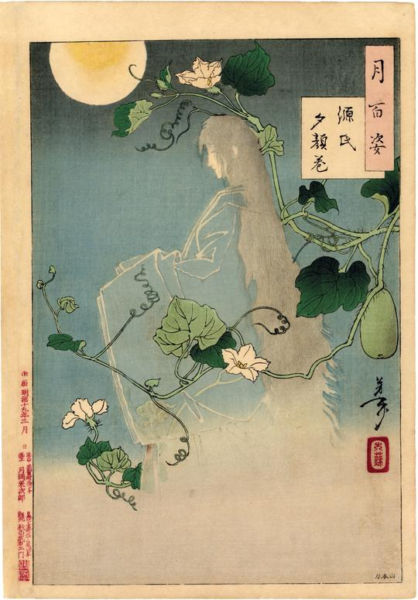
Tsukioka Yoshitoshi, 1886, Yūgao, No.29 from the series One Hundred Aspects of the Moon, Scripps College, Claremont, CA
Yōkai are mysterious phenomena and bizarre beasts that have inhabited Japan’s landscapes, homes, folklore and imagination for many centuries. They can be evil or benign spirits, ranging from shape-shifting animals—often foxes and badgers—to vengeful ghosts. The term yōkai also encompasses supernatural creatures in folklore such as kappa, tengu, and oni. Kappa, water-dwelling, turtle-shelled goblins, pull people and horses into rivers if not properly appeased with cucumbers. Tengu, bird-men hybrids who live in mountain forests, can guide or deceive humans. Oni, ogre-like demons, cause harm and havoc—devastation, storms and even plagues. Yōkai can also be objects like umbrellas and lanterns that mysteriously come to life.
Many of these creatures and their activities have been described in historical, religious and literary texts, and over the centuries, Japanese artists have attempted to capture their likenesses. In the Edo (1603-1868) and Meiji (1868-1912) periods, in particular, many artists who designed woodblock prints depicted these supernatural phenomena in pieces that were eagerly consumed by a population fascinated with the mysterious and macabre.
This exhibition features 90 Japanese woodblock prints, printed books (e-hon) and votive slips (senjafuda), spanning over 200 years, that showcase the supernatural from the Scripps College collection in Claremont, CA. Celebrated artists Ando Hiroshige (1797-1858), Utagawa Kuniyoshi (1798-1861), and Utagawa Kunisada (1786-1864) from the Edo period and Tsukioka Yoshitoshi (1839- 1892) and Yoshu Chikanobu (1838- 1912) from the Meiji era, masterfully portrayed some of the creepiest creatures and most grotesque ghouls in Japanese art. Many of their yōkai have inspired depictions in manga and anime today.
The works will be grouped into six sections: 1) Introduction to the Supernatural; 2) Yōkai of the Natural World (Land, Sky and Water); 3) Animal Magic, Monsters and Transformations; 4) Demons (Oni and Kijo); 5) Ghosts (Bakemono, Obake, Yūrei); and 6) Spooky Objects (Tsukumogami).
The prints and printed books in this exhibition illustrate not only the history of Japanese art, but also traditional literature, theater and belief systems. Yōkai offer a unique, sometimes comical, and even spine-chilling peak into Japanese culture, one that will spirit visitors away to the realm of the supernatural!
Meet the Curator
Meher McArthur is a Los Angeles-based Japanese art historian, who has curated the traveling exhibitions Folding Paper: The Infinite Possibilities of Origami (2012-2016) and Above the Fold: New Expressions in Contemporary Origami Art (2015-2020) and co-curated Nature, Tradition and Innovation: Japanese Ceramics from the Gordon Brodfuehrer Collection (2016-2019).
Additionally, McArthur has published a wide variety of books relating to Asian art, including Gods and Goblins: Japanese Folk Paintings from Otsu, Pacific Asia Museum, Pasadena (1999); Reading Buddhist Art: An Illustrated Guide to Buddhist Signs and Symbols, Thames & Hudson, London and New York (2002); and The Arts of Asia: A Guide to Materials, Techniques and Styles, Thames & Hudson, London and New York (2005). McArthur received an MA in Japanese Studies from Cambridge University; a postgraduate diploma in Asian Art from Sotheby’s School of Oriental Studies (SOAS), London University; and an MA in Art and Archaeology from SOAS, London University. Former positions include Art and Cultural Director at JAPAN HOUSE Los Angeles, Curator of East Asian Art at Pacific Asia Museum, and Gabrielle Jungels-Winkler Curator of Academic Programs & Collections at Scripps College.

